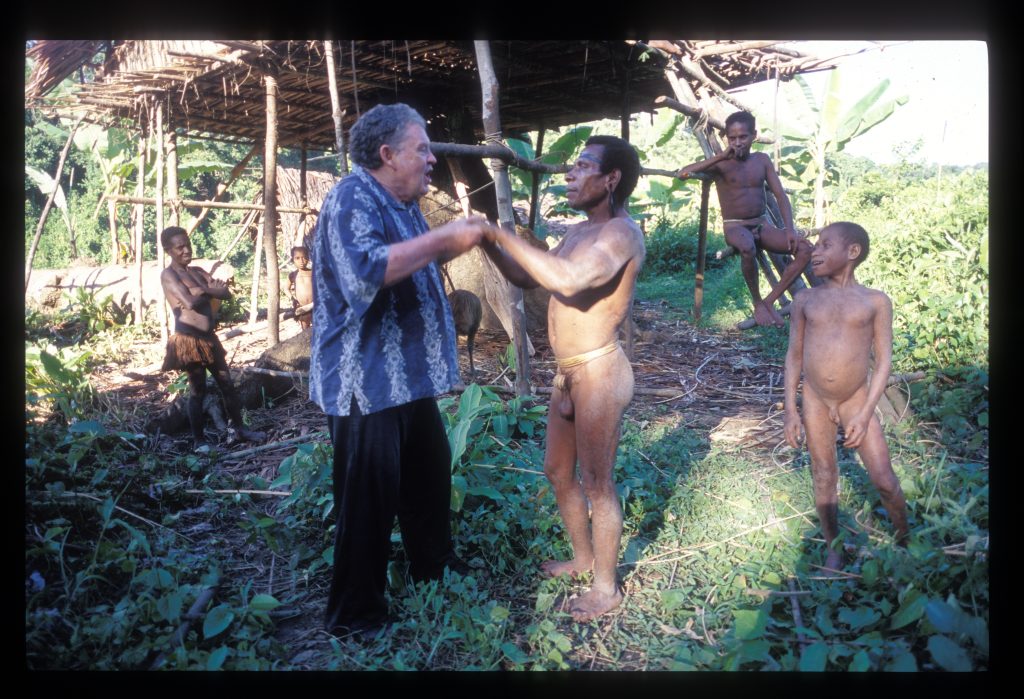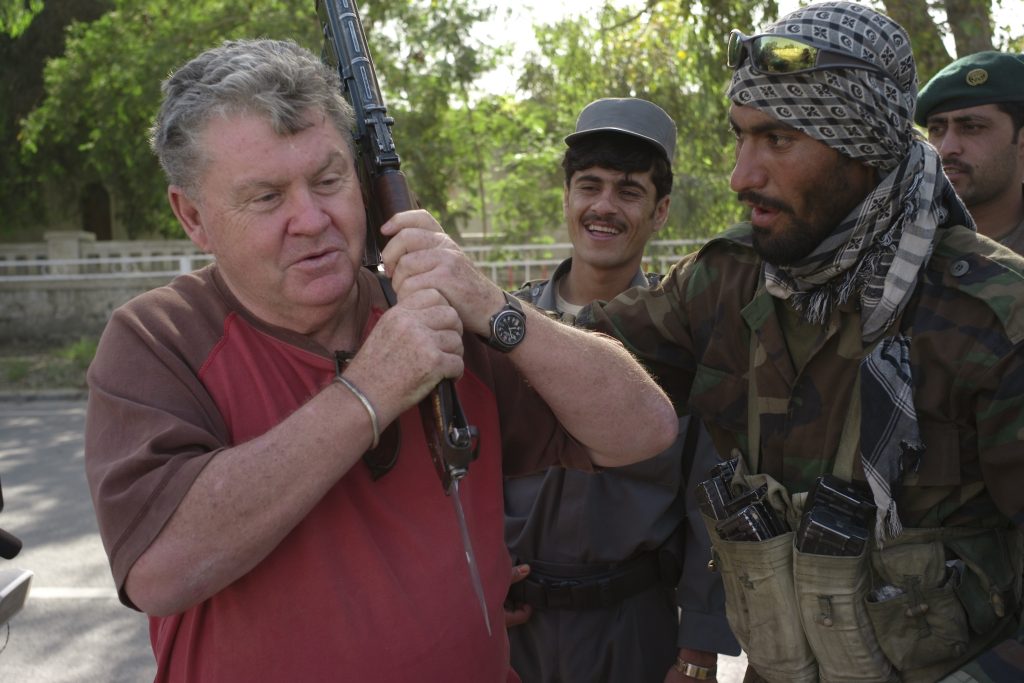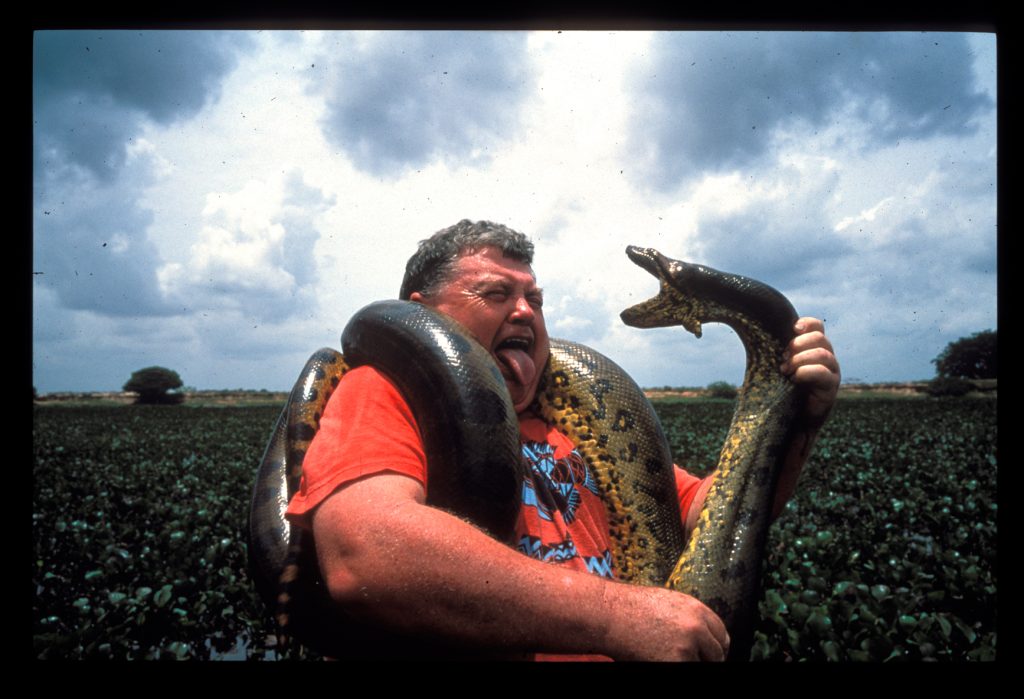By Paul Raffaele
Paul Raffaele is a journalist and foreign correspondent who created and specialises in ‘adventure with meaning.’ Paul reflects on his career and how a life of adventure is possible if you have the belief to make it happen and you’re willing to work at it.
Sleeping With Cannibals by Paul Raffaele, Smithsonian magazine, 2006
For days I’ve been slogging through a rain-soaked jungle in Indonesian New Guinea, on a quest to visit members of the Korowai tribe, among the last people on earth to practice cannibalism. Soon after first light this morning I boarded a pirogue, a canoe hacked out of a tree trunk, for the last stage of the journey, along the twisting Ndeiram Kabur River. Now the four paddlers bend their backs with vigour, knowing we will soon make camp for the night.
My guide, Kornelius Kembaren, has travelled among the Korowai for 13 years. But even he has never been this far upriver, because, he says, some Korowai threaten to kill outsiders who enter their territory. Some clans are said to fear those of us with pale skin, and Kembaren says many Korowai have never laid eyes on a white person. They call outsiders laleo (“ghost-demons”).
Suddenly, screams erupt from around the bend. Moments later, I see a throng of naked men brandishing bows and arrows on the riverbank. Kembaren murmurs to the boatmen to stop paddling. “They’re ordering us to come to their side of the river,” he whispers to me. “It looks bad, but we can’t escape. They’d quickly catch us if we tried.”
As the tribesmen’s uproar bangs at my ears, our pirogue glides toward the far side of the river. “We don’t want to hurt you,” Kembaren shouts in Bahasa Indonesia, which one of our boatmen translates into Korowai. “We come in peace.” Then, two tribesmen slip into a pirogue and start paddling toward us. As they near, I see that their arrows are barbed. “Keep calm,” Kembaren says softly.
Cannibalism was practiced among prehistoric human beings, and it lingered into the 19th century in some isolated South Pacific cultures, notably in Fiji. But today the Korowai are among the very few tribes believed to eat human flesh. They live about 100 miles inland from the Arafura Sea, which is where Michael Rockefeller, a son of then-New York governor Nelson Rockefeller, disappeared in 1961 while collecting artefacts from another Papuan tribe. His body was never found. Most Korowai still live with little knowledge of the world beyond their homelands and frequently feud with one another. Some are said to kill and eat male witches they call khakhua.
 Caption: In Indonesian New Guinea with the war chief of a cannibal tribe, the Korowai. This clan had not seen a white person before, and he is giving a ritual welcome.
Caption: In Indonesian New Guinea with the war chief of a cannibal tribe, the Korowai. This clan had not seen a white person before, and he is giving a ritual welcome.
This is the opening to a feature I wrote for the prestigious U.S. magazine, Smithsonian, entitled Sleeping With Cannibals. The object of such an opening to a long-form feature is to draw the reader in, making them eager to read on to see how the incident develops. I revisit this scene, and its conclusion, much later in the feature, as I retrace my steps from when I began my journey into the land of the New Guinea cannibals. In this case, the bellicose tribesmen demanded money from us to buy a pig to be sacrificed to the river god to absolve we outsiders from the grievous sin of daring to come into their forbidden territory. It was a Stone Age shakedown.
For decades, I have been giving advice freely to writers who’ve approached me to ask about how I got started in writing features, and how I go about my work. Write On!’s recent theme, ‘Creating With Courage And Perseverance,’ attracts me for reasons that will become obvious.
I began my career in writing long-form features without any training in that form, or any prospects of succeeding. My training was as a broadcast journalism cadet in the Australian Broadcasting Commission (similar to the BBC). I was a co-founder of the Current Affairs department, which pioneered that type of broadcast reporting in Australia in the late 1960’s.
In 1973, I became an ABC foreign correspondent, the first-ever Australian journalist to be resident in Mao’s China, in Beijing, at a time when China was largely closed to the world. The British monthly magazine, The Critic, recently ran a chapter of mine in a book about China which details my reporting style there.
I then moved to be the ABC’s Southeast Asian Correspondent based in Bangkok, covering the aftermath of the Indochina wars. In 1976, I was brought back to Melbourne to head the Current Affairs department for the state of Victoria, the heir apparent to the head of the ABC’s national Current Affairs department. Both positions are very influential in the political and social life of Australia.
But, since childhood, I had been captivated, both by the power of the written word and by the prospect of adventure in remote places and with remote peoples. I had a taste of that while based in Bangkok when I trekked into forbidden Burmese territory to visit a Hmong tribal village where they grew opium. I found the danger involved thrilling and very seductive. As well, the story had much meaning, as the villagers sold their opium crop to illegal heroin manufacturers.
I have a very understanding wife, and I soon resigned from the ABC and, with my wife and baby daughter, moved back to Bangkok to be a long-form feature writer specialising in adventure with meaning.
I had no training in this form of journalism, and only a couple of contacts, but I was determined to give it a year or two to see if I could make a success of it. I decided to write solely in the first person, not because of ego, but because I wanted to give readers the sense that they were with me on each journey. I did not then know the adage, ‘Show don’t tell,’ but that is what I based my technique on. I also wanted to do features of my choice, and not that of an editor, because then both my heart and mind would be guiding my work.
I understood that I had to build momentum; that I was unlikely to get assignments from editors when I was not able to show them previous publications of my work. I couldn’t because I had none. So, initially, I had to fund my own journeys. Luckily, the sort of features I wanted to write fitted in with one of the U.S.’s most prestigious magazines, Parade. It has a weekly circulation of 24 million and goes into many Sunday newspapers across the country such as The Washington Post and the Los Angeles Times.
Parade’s editor-in-chief liked the way I wrote my features, and my willingness to take risks in dangerous places to get the best results. He became my mentor. Nonetheless, it was still a hard slog, because Parade could not fund me full-time. We’d moved to Hong Kong and, because the rents were so high on the island and in Kowloon, we lived on a small island, Cheung Chau, an hour by ferry to Hong Kong Island.
After eight years based in Hong Kong and Tokyo, we returned to Sydney, because my daughter had entered First Year High School. We preferred that she did high school in Sydney and then go on to the University of Sydney. She did and now lectures at university.
Once more, I was starting from scratch, because there was not much interest in stories from Australia for Parade and my other magazines. I could have returned to the ABC in a high position, but I had grown to love being a long-form feature writer of ‘adventure with meaning’. I contacted the Australian office of Reader’s Digest, and the editor-in-chief agreed to an assignment I suggested, a little-known bay in a remote part of Western Australia, where friendly wild dolphins were swimming into the shallows each day to frolic with local people.
The Digest ran the feature in all its editions, with up to one hundred million readers in 19 languages worldwide, and my career with the Digest was launched. I became a Roving Editor: in effect, one of a handful of Digest foreign correspondents and wrote ‘adventure with meaning’ features on all continents, including the Antarctic. My many scores of Digest features were very popular with readers of the British edition, which, at the time, was one of Britain’s most popular magazines, with top writers.
Perseverance, and self-belief, were really important in making it a success. I developed my own technique, never having had a lesson in feature writing, but I voraciously read the very best writers of such features. I found the Granta specials to be especially helpful. And I constantly examined my own work, not to congratulate myself, but to see if I could spot any weaknesses and then correct them.
I come from the same generation as Steven Spielberg and George Lucas. A common pleasure in our lives were the Saturday afternoon shows at the local cinemas. There, before the movie, they showed ‘Serials’: 30-minute adventures featuring such fearless characters as Jungle Jim in Africa. Each serial had a dozen episodes, and each ended with a hook, the hero in a dangerous spot. Could he fight or think his way out of the extreme danger? Hey kids, come back next Saturday to see!
Spielberg and Lucas used this technique in the Indiana Jones series, though each threatening incident in each movie was sorted out in the relevant movie. The famous scene where the huge ball of stone hurtled towards Indy in Raiders Of The Lost Ark came directly from a Saturday afternoon serial I was thrilled by as a young boy.
That is how I got the idea to begin each long-form feature with a dangerous, relevant incident involving the main character in the feature, and stopping just at the point before the danger was overcome, as you’ll have read in the extract above. I continued to write almost all my 100+ long-form features in the first person.
I moved on to Smithsonian magazine, and The Washington Post eventually ran a 1,400-word, positive profile of me. Jennifer Lopez and Matt Damon pushed me into the corner on page one of its Style section, but I got most of page two with three photos of me.
I wrote two-dozen long-form, adventure-with-meaning features for Smithsonian magazine. Several were cover stories and scoops. I suggested all the story ideas to the editor-in-chief, and, happily, he agreed to commission them.
 Caption: In Jalalabad, Afghanistan, just before the Taliban suicide bombing, where a 12-year-old boy blew himself up on a police base, killing 20 paramilitary police and commandoes and seriously injuring 30 of us.
Caption: In Jalalabad, Afghanistan, just before the Taliban suicide bombing, where a 12-year-old boy blew himself up on a police base, killing 20 paramilitary police and commandoes and seriously injuring 30 of us.
For my first Smithsonian feature, I journeyed to the dangerous Central African Republic to do a feature focused on a brave American primatologist battling poachers to save rare western lowland gorilla families living in its forests.
Here is how I started that feature, entitled: Stop The Carnage
The dense treetop canopy plunges day into night as we enter the rain forest. We are about 300 miles north of the Equator, in the Central African Republic, and the jungle vibrates with the haunting shrieks of insects as we clamber over fallen logs and step around giant trees strung with thorn-studded vines. Lurking overhead, I am told, are cobras. Leading the way is Babangu, a Pygmy tracker. He is followed by two tall Bantu paramilitary guards, clad in camouflage and toting AK-47 assault rifles. David Greer, a 35-year-old American who leads the anti-poaching patrols, is armed with a nine-millimetre pistol.
Shotgun shells litter the animal paths. “They’re fresh, the poachers have probably been here today,” Greer whispers. I gulp with fear, knowing that the poachers carry AK-47s and elephant guns. Babangu points to a poacher’s snare—a wire loop buried in the fallen leaves and attached to a bent sapling. Greer snips the wire and uproots the trap.
Babangu leads us to a red duiker, a dog-sized antelope, caught in a snare. It’s dead. “This could have been a gorilla, a chimp or a leopard,” Greer whispers as we squat by the body. His eyes harden as he sees that the duiker had almost torn off a front leg trying to free itself from the trap.
We leave the animal in search of more snares. In two hours walking the jungle, we find another 171. Greer and his 48 men have destroyed more than 30,000 of the illegal devices in the past year, putting a big dent in the poachers’ haul of forest animals. But Greer knows that much more needs to be done.
Later, on our way back, we pass by the spot where the duiker had been snared. The carcass has vanished. Greer grimaces. “The poachers must have been nearby,” he whispers. “If we’d stumbled on them, there could have been shooting.”
Illegal hunting is devastating wildlife across sub-Saharan Africa. “The African bushmeat trade is huge,” Jane Goodall, the distinguished primatologist (and Greer’s mentor), told me in an e-mail. “Tons and tons of wild animal meat [is] trucked into the urban centers, and a good deal is shipped to other African countries and to other continents.”
Smithsonian chose my first feature as a cover story with a photo of a magnificent silverback. I might have earned a lot more money as a senior broadcast current affairs executive, but I would not have had one hundredth as much fun and excitement, and experienced fascinating knowledge in faraway places among charismatic peoples and animals. I have journeyed with, and remain friends with, many of the world’s most interesting people, such as David Greer and Jesus Rivas, son of a Venezuelan tribal man. Jesus is the world’s premier expert on anacondas. Over two weeks, in remote Venezuelan wetlands, we battled and caught 82 massive anacondas to weigh, measure and release back unharmed into their watery habitats.
 Caption: Catching one of the 82 anacondas in the Venezuelan swamp land, before releasing them.
Caption: Catching one of the 82 anacondas in the Venezuelan swamp land, before releasing them.
So, no regrets from me. I retain countless, unforgettable memories because of my career as a freelance adventure writer.
*****
If you’d like to read more of Paul’s work, you can find a selection via the links below:
Smithsonian Magazine, Articles by Paul Raffaele
The Critic, The Masses Might Even Stone You by Paul Raffaele
*****
Paul has published six narrative non-fiction books, which you can find out more about on his Amazon author page. He is currently working on his debut novel, Rajah Hawke, a compelling adventure set in the 19th century, between the jungles and seas of Borneo and Brunei.
*****



